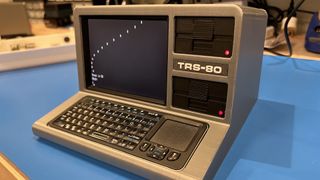One of the first home computers resurrected — Raspberry Pi and 3D printing brings faux TRS-80 to life
Another venerable example of computer history revived

Many of us got our start in computers through a joint venture between Tandy and Radio Shack stores, the TRS-80. Joe Pasqua relives those days with a 40%-scale replica he built using 3D printing and a Raspberry Pi to emulate the ancient operating system. It even includes a cutout for a working keyboard and trackpad.
Pasqua designed the project to capture the feel of the TRS-80 Model 3 or Model 4 but acknowledges it’s not a replica. Instead, he’s incorporated his favorite aspects of each into the design. The project bears the most resemblance, cosmetically, to the TRS-80 Model 4.
The TRS-80 Micro Computer System was introduced in 1977 when Tandy launched it for sale in its Radio Shack stores. Initially, it used the popular Zilog Z80 processor, and several successors followed over the next few years. In 1983, the Model 4 got a faster Zilog Z80A CPU and a larger display.
The 3D-printable design includes a 5-inch 640x480 display and two decorative but non-functional floppy drives. The floppy drives have LEDs that can flash randomly to help convey the feel of the classic 1980s computer. The cutout below, where the original TRS-80 would include a keyboard, is designed to hold an inexpensive, off-the-shelf wireless keyboard and trackpad.



To turn this project from a 3D-printed decoration into something usable, Pasqua has incorporated a place inside the case to hold a Raspberry Pi. The maker says it can work with anything from a Raspberry Pi 3 Model B to the latest Raspberry Pi 5, but for his purposes, he’s using a Raspberry Pi 4.
You could run this as a Raspberry Pi microcomputer, but where’s the fun in that? Pasqua found an emulator to run the original TRSDOS operating system. The trs80gp emulator allows the Raspberry Pi to act as any model of TRS-80, from Model 1 to the later Color Computer.
Stay On the Cutting Edge: Get the Tom's Hardware Newsletter
Get Tom's Hardware's best news and in-depth reviews, straight to your inbox.

Jeff Butts has been covering tech news for more than a decade, and his IT experience predates the internet. Yes, he remembers when 9600 baud was “fast.” He especially enjoys covering DIY and Maker topics, along with anything on the bleeding edge of technology.
-
Hooda Thunkett I still have my model III in the garage. Been meaning to see if it still boots. Maybe this weekend.Reply -
mickrc3 Bought my Model 1 in 1979 and learned to program it. Upgraded it from Level 1 Basic to Level 2, upgraded memory to 16K and then added the Expansion Interface with another 32K of RAM for the system max of 48K. Replaced the cassette interface with an Exatron Stringy Floppy drive (Endless Reel tape drive). Added a floppy drive and controller and upgraded to TRS-DOS and then to NewDOS80. Had the Tandy Screen Printer, added a thermal printer from DAK, and finally a Epson MX-70. In less than a year I switched careers in the Air Force and went to programming school. I finished a 42 year career for DOD in 2019, with 38 years of that being a computer programmer.Reply -
abufrejoval My first contact with computers was via a Model II in a technical college in Ohio, where I took a class in Basic programming in 1980.Reply
It's become my career, although Basic faded rather quickly. -
Sippincider Model III was my first computer as well!Reply
The floppy drives have LEDs that can flash randomly to help convey the feel of the classic 1980s computer.
Should configure them to light during actual storage I/O. :) -
kdw75 Reply
I still have all of our old computers. The oldest is my Dad's Tandy Model I. We also still have the III, IV, 1000s, and a half dozen Macs including a IIfx. They are all sitting on shelves in the storage room at our business.Hooda Thunkett said:I still have my model III in the garage. Been meaning to see if it still boots. Maybe this weekend. -
Joseph_138 A Model III/IV is one of the few vintage machines that I don't have in my collection, yet. The size, and weight, makes shipping cost prohibitive, because of the CRT, and I haven't been able to find one locally that is in working condition.Reply -
Bitsplusatoms Reply
Hi, I’m the creator of this model and I agree about the LEDs. The emulator is closed source so I looked for ways to detect I/O activity externally (e.g. monitor system calls). The wonderful authors of the emulator explained why that won’t work and are considering adding a feature that will allow me to do this.Sippincider said:Model III was my first computer as well!
Should configure them to light during actual storage I/O. :)
Most Popular



